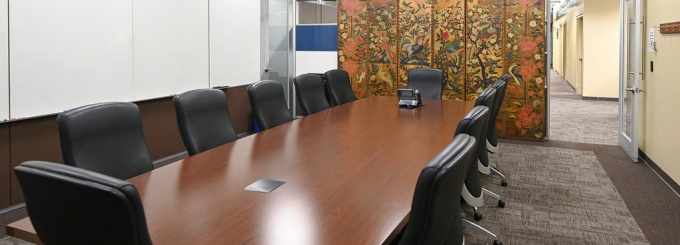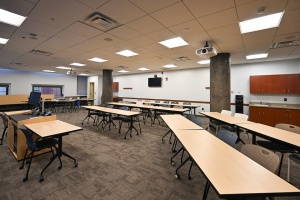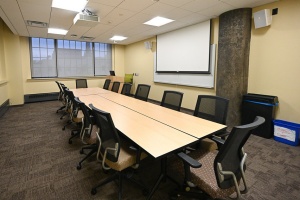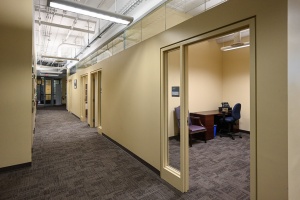
Dedicated law school space downtown
UB School of Law now has a foothold in the heart of downtown Buffalo, not far from the critical mass of lawyers and courts doing business there.
The law school has dedicated space in a second-floor suite of the UB Downtown Gateway, a beautifully refurbished former factory at 77 Goodell St. between Ellicott and Oak streets. The space includes offices, classrooms and a conference room.
It marks the law school’s first permanent location downtown since the school left its home at 77 W. Eagle St. for the new North Campus in 1973. It will house the law school’s Advocacy Institute, the umbrella unit for litigation training opportunities, and afford a space for student attorneys in the Clinical Legal Education Program to meet with clients and community partners.
View photos from our recent Advocacy Institute Reception.
“This enables us to have a presence downtown, but it also permits us to have clients meet us in the city. It connects our students to the city and our city to the students,” says Professor Anthony O’Rourke, Joseph W. Belluck and Laura L. Aswad Professor of Civil Justice and director of The Advocacy Institute. “Our trial technique and trial team professors can teach close to their offices and near where the legal action is.” The Downtown Gateway is just a one-mile walk from Buffalo City Court.
It’s also convenient to public transportation; Metro Rail’s Fountain Plaza station is a mile away. That’s important for students who don’t have a car, because they can take the UB shuttle to the South Campus Metro station and the train from there. The location also makes for easier access for clients of the law school’s clinics, many of them on limited incomes, who live in the city.
“The addition of a downtown venue for our students is a game changer,” says Terrence M. Connors ’71, chair of The Advocacy Institute’s national advisory board. “Our Innocence and Justice Project is really gaining momentum and a downtown facility will not only establish our physical presence but accommodate our clients and give us easy access to the courts.”
“We have been working toward downtown space for years, and we’re thrilled to have this space for our student attorneys, clients and community partners in the Clinical Legal Education Program,” says Professor Kim Diana Connolly, vice dean for advocacy and experiential education. “We have already used it for meetings with clients, restorative circle work, gatherings with our community partners, and a place for clinical instructors to stop and work between court appearances and other downtown obligations.”
Administrators are also looking at scheduling some classes in the new location, possibly as early as the spring semester.
“Most of our students have a tremendous interest and desire to be more connected to the Buffalo legal community, and this provides a forum for doing so.” O’Rourke says. “The mission of The Advocacy Institute is something we take very seriously: to instill in our students the skills, discipline and ethics necessary to become creative and principled litigators. This new building is a true accomplishment of the law school in the service of that mission, and we are grateful to the university for investing in the law school in this way.”
The building itself demonstrates the rewards of adaptive reuse. Constructed to house the M. Wile & Co. clothing factory, it was built in 1924 and is recognized as an early example of an architectural style known as “Daylight Factory.” This type of multi-story factory building used reinforced concrete in an exposed frame system of construction, with the spaces between exterior piers filled almost entirely with steel sash windows—a great advantage over brick walls and wood floors in fireproofing, lighting and spaciousness.


